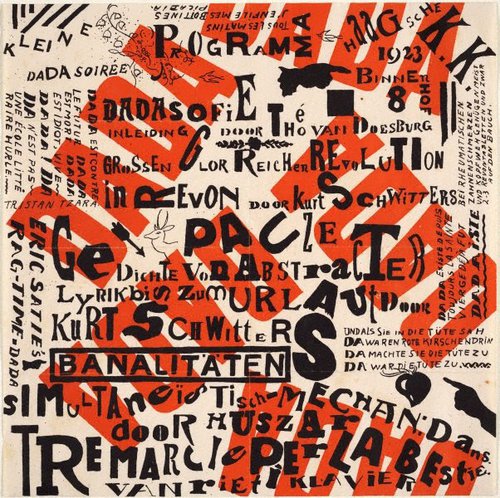-
Details
- Date
- 1943
- Media category
- Collage
- Materials used
- collage on paper
- Dimensions
- 23.0 x 19.0 cm image/sheet; 37.0 x 25.5 cm original paper
- Signature & date
Signed and dated c. verso paper, pencil "Kurt Schwitters 1943". Signed l.l. paper, pencil "Kurt Schwitters".
- Credit
- Purchased with funds provided by the Ruth Komon Bequest in memory of Rudy Komon 2004
- Location
- Not on display
- Accession number
- 131.2004
- Copyright
- © Kurt Schwitters/ADAGP. Licensed by Copyright Agency
- Artist information
-
Kurt Schwitters
Works in the collection
- Share
-
-
About
Collaged in war-ravaged London in 1943, the title, 'Out of the dark' may be a reference to renewed optimism in the efforts of the allied forces or perhaps to the possibility of being able to work in daylight after the long nights of enforced blackout. Although collaged from an Australian fruit label, emphasis is given in the composition to the words "British Empire". Considering the artist's poverty and obvious alienation as a German citizen in London, it is also an ironic reference to the deprivation of the times; a box of fresh apples would have been an extreme luxury and the artists lifestyle is hinted at through the bus ticket to the Fulham Road and the single one penny coin (with Britannia turned decidedly on her head). While other words in the label have been shortened to create typical Merz nonsense, (HOBA from Hobart and ERC from E.R.C. Cottier), the subtle defacing of the word 'Apples' turns the main slogan into "British Empire A ples" suggesting, perhaps, a less appreciative opinion of his host nation (Ah Please!).
Schwitters' early collages of the 1920s have a very individual style, and yet they clearly derive from Cubism in their faceted handling of pictorial space. The overall abstract composition is more important than individual collaged elements and the inclusion of found printed material is more a celebration of the beauty of junk than a comment on consumerism. Schwitters saw this as the major difference between Berlin Dada and Merz; as he wrote in 1920: "Dadaism is politically oriented, against art and against culture" whereas "Merz strives after nothing but art". As his work developments, influenced by his contact with artists from the Bauhaus and de Stilj in Holland, the pictorial space became flatter and pronounced straight lines in the edges of applied collage gave the work a more graphic, constructive appearance.
The major change that occurs in some of Schwitters' English collages is the fuller use of found imagery as the predominant element in the overall composition which inevitably suggests more 'meaning' to the work. The overall abstract composition is no longer more important than individual collaged elements. Another collage from the year before 'The Proposal' 1942 (also known as 'The Courtship') uses as its base a 19th century lithographic illustration of a family sitting around a table that is almost puritan in its restraint on which is collaged reproductions from a glossy magazine of plates of food - biscuits, roast chicken, doughnuts, tarts etc. The culture of prosperity alluded to in this and other 1940s collages is very obviously America, as gleaned by Schwitters through American magazines sent to him by his friend Käte Steinitz who had emigrated there in 1936. In one of her letters to Schwitters she described American eating habits claiming 'they ate applepie with American cheese, pears with creamcheese and ham with pineapple and everything with everything'. Realizing the fact that none of these foods were available in London she concluded: "I wish I could feed ALL my European friends which are left instead of telling food stories."
The shift, in Schwitters' collages from an emphasis on composition to a subtle, yet unmistakable, social comment is the most important development to emerge in the work of his late 'in exile' period. While visually, this may appear to be a seemingly insignificant shift in emphasis, it has much in common with the early work of The Independent Group which, in turn, developed into Pop Art.
In 1945, Eduardo Paolozzi, one of the founding members of the Independent Group, also began to make collages based on the fantasy life of American culture seen through the pages of imported glossy magazines. Paolozzi, thirty-seven year younger than Schwitters, started collecting images from illustrated magazines in 1943 when he was studying at Edinburgh College of Art to become a commercial graphic artist, but did not start to use them in collages until 1945 when he enrolled at St Martins School of Art and was exposed to Schwitters' and Surrealist collages, exhibited at E.L.T. Mesen's London Gallery. In a 1996 interview, Paolozzi said "So the idea of collage did not come to me at art school, but at the sight of Schwitters' collages, which I even saw in the original as far as possible."
-
Exhibition history
Shown in 4 exhibitions
1944 December exhibition: masterpieces by great masters, Modern Art Gallery, London, London, Dec 1944–Dec 1944
Schwitters, Arp, Kunstmuseum Basel, Basel, 01 May 2004–22 Aug 2004
Kurt Schwitters acquisition and related works from the collection, Art Gallery of New South Wales, Sydney, 29 Nov 2004–17 Apr 2005
20th-Century galleries, lower level 1 (rehang), Art Gallery of New South Wales, Sydney, 20 Aug 2022–2023
-
Bibliography
Referenced in 4 publications
-
Kunstmuseum Basel, Schwitters, Arp, Basel, 2004.
-
Modern Art Gallery, London, 1944 December exhibition: masterpieces by great masters, London, 1944. cat.no. 7a
-
Jill Sykes (Editor), Look, Sydney, May 2008, 47 (colour illus.).
-
Michael Wardell, Look, 'Out of the dark: Kurt Schwitters, the one-man art movement', pg.14-15, Sydney, Aug 2004, 14-15, 14 (colour illus.).
-

